HRM Challenges: Issues with the Employee Turnover in Tourism Sector
VerifiedAdded on 2023/06/12
|12
|2719
|452
AI Summary
The report discusses the uncertainties created in the tourism sector due to increasing rate of employee turnover. It identifies the reasons and provides recommendations to mitigate the issues.
Contribute Materials
Your contribution can guide someone’s learning journey. Share your
documents today.
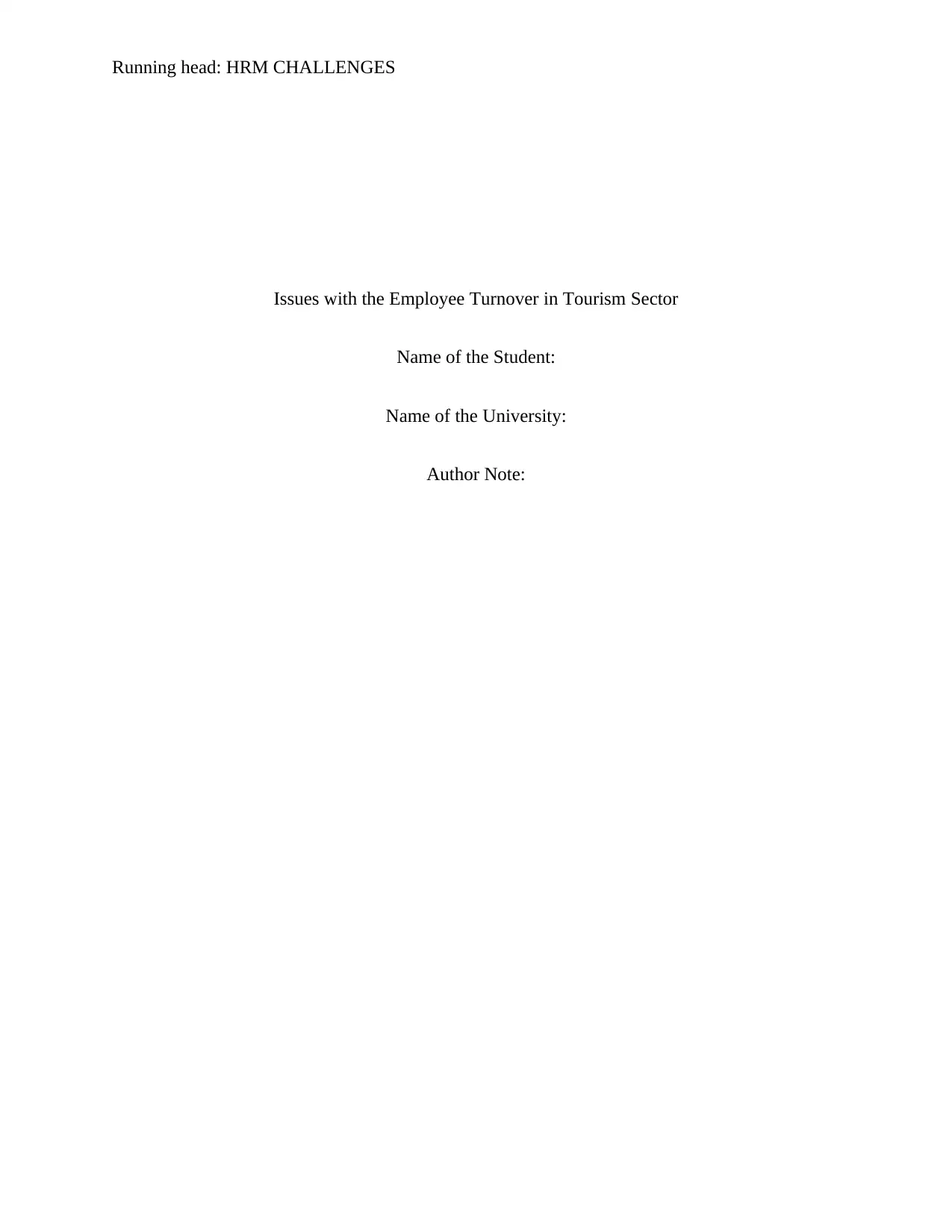
Running head: HRM CHALLENGES
Issues with the Employee Turnover in Tourism Sector
Name of the Student:
Name of the University:
Author Note:
Issues with the Employee Turnover in Tourism Sector
Name of the Student:
Name of the University:
Author Note:
Secure Best Marks with AI Grader
Need help grading? Try our AI Grader for instant feedback on your assignments.
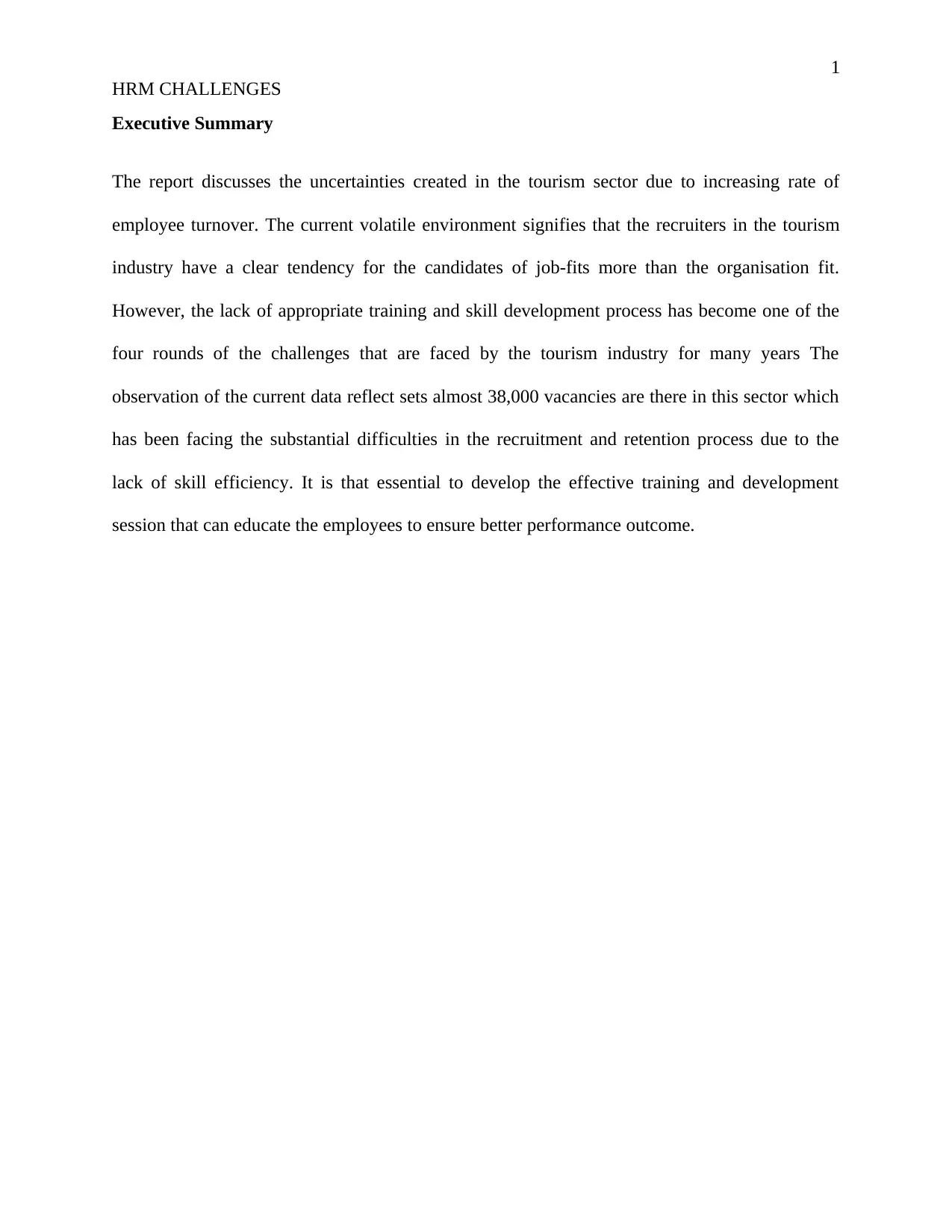
1
HRM CHALLENGES
Executive Summary
The report discusses the uncertainties created in the tourism sector due to increasing rate of
employee turnover. The current volatile environment signifies that the recruiters in the tourism
industry have a clear tendency for the candidates of job-fits more than the organisation fit.
However, the lack of appropriate training and skill development process has become one of the
four rounds of the challenges that are faced by the tourism industry for many years The
observation of the current data reflect sets almost 38,000 vacancies are there in this sector which
has been facing the substantial difficulties in the recruitment and retention process due to the
lack of skill efficiency. It is that essential to develop the effective training and development
session that can educate the employees to ensure better performance outcome.
HRM CHALLENGES
Executive Summary
The report discusses the uncertainties created in the tourism sector due to increasing rate of
employee turnover. The current volatile environment signifies that the recruiters in the tourism
industry have a clear tendency for the candidates of job-fits more than the organisation fit.
However, the lack of appropriate training and skill development process has become one of the
four rounds of the challenges that are faced by the tourism industry for many years The
observation of the current data reflect sets almost 38,000 vacancies are there in this sector which
has been facing the substantial difficulties in the recruitment and retention process due to the
lack of skill efficiency. It is that essential to develop the effective training and development
session that can educate the employees to ensure better performance outcome.
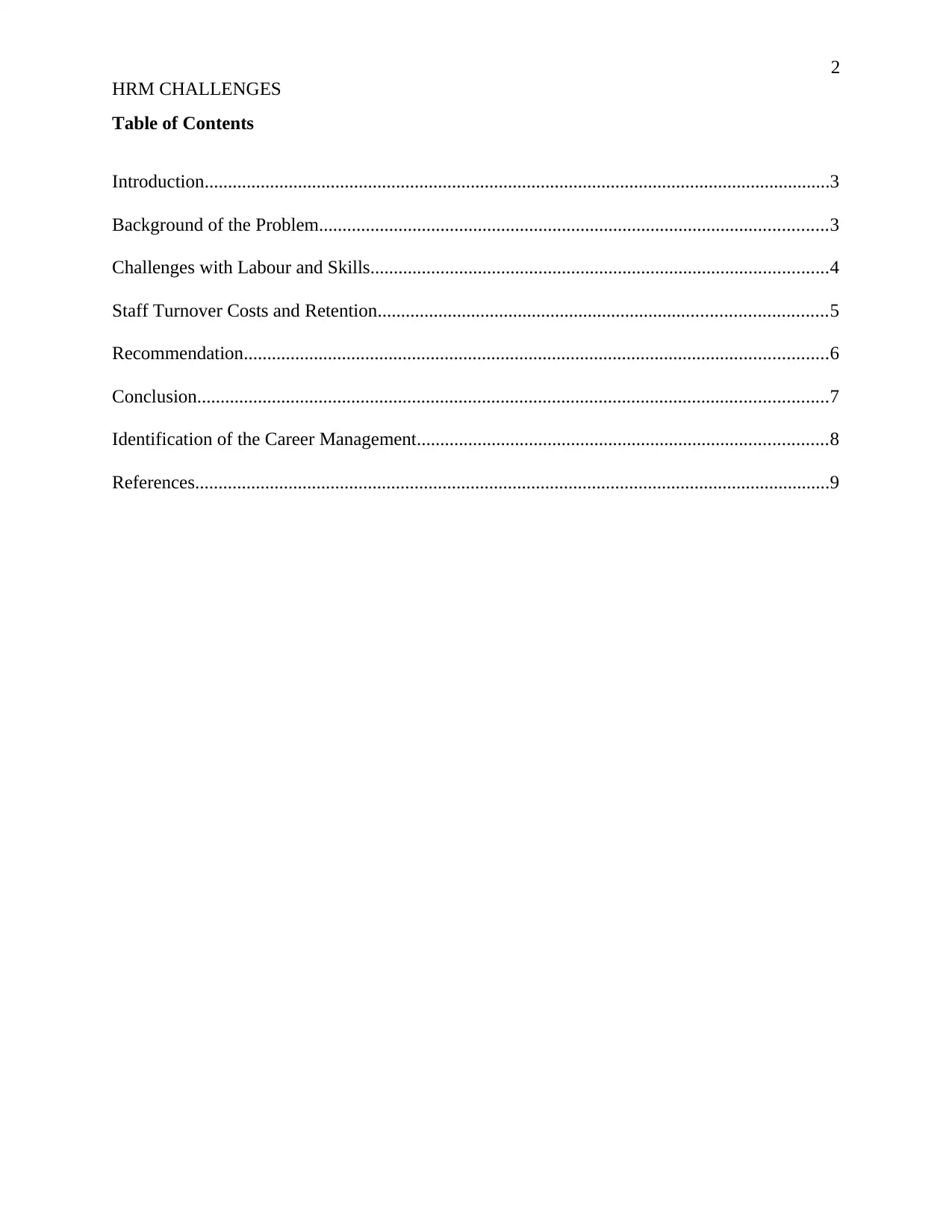
2
HRM CHALLENGES
Table of Contents
Introduction......................................................................................................................................3
Background of the Problem.............................................................................................................3
Challenges with Labour and Skills..................................................................................................4
Staff Turnover Costs and Retention................................................................................................5
Recommendation.............................................................................................................................6
Conclusion.......................................................................................................................................7
Identification of the Career Management........................................................................................8
References........................................................................................................................................9
HRM CHALLENGES
Table of Contents
Introduction......................................................................................................................................3
Background of the Problem.............................................................................................................3
Challenges with Labour and Skills..................................................................................................4
Staff Turnover Costs and Retention................................................................................................5
Recommendation.............................................................................................................................6
Conclusion.......................................................................................................................................7
Identification of the Career Management........................................................................................8
References........................................................................................................................................9
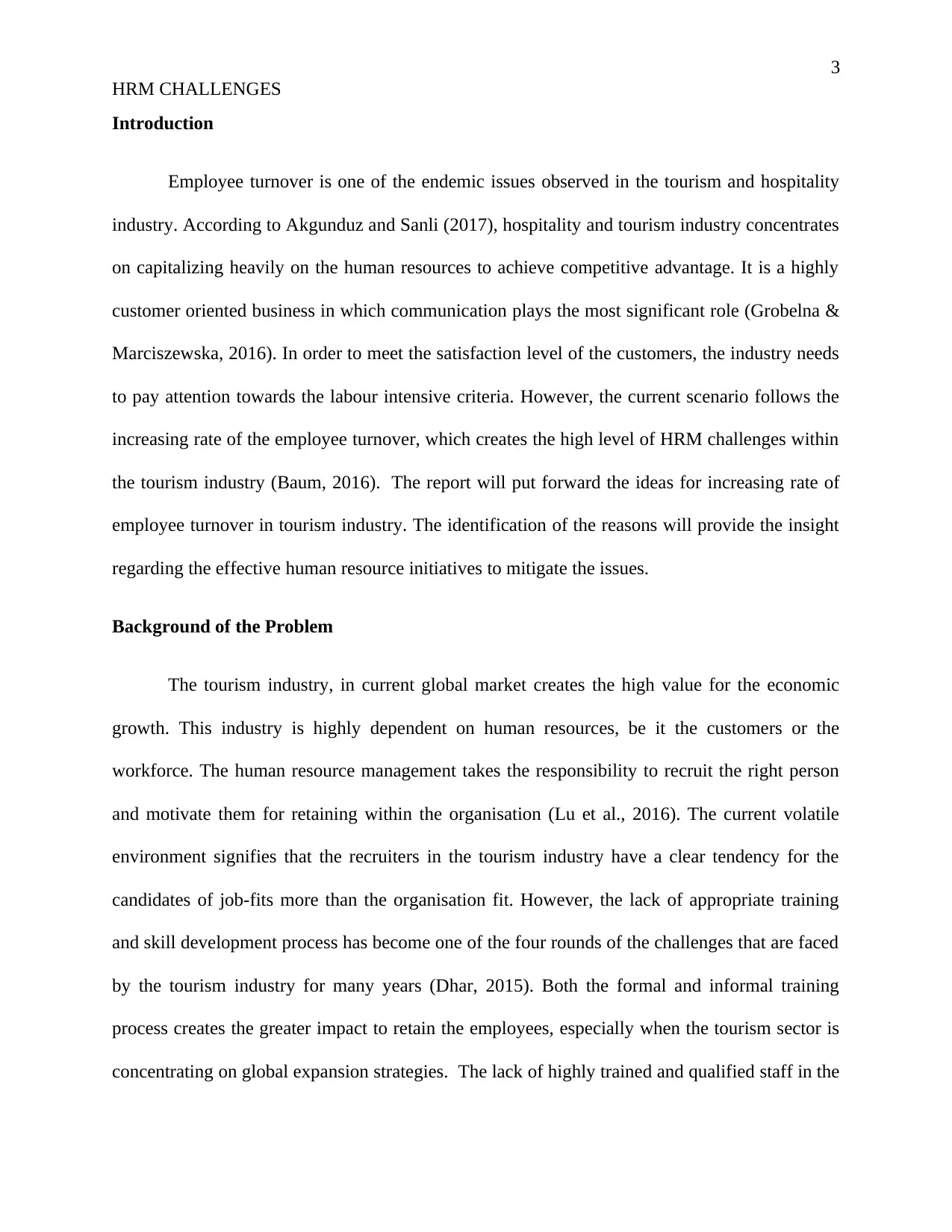
3
HRM CHALLENGES
Introduction
Employee turnover is one of the endemic issues observed in the tourism and hospitality
industry. According to Akgunduz and Sanli (2017), hospitality and tourism industry concentrates
on capitalizing heavily on the human resources to achieve competitive advantage. It is a highly
customer oriented business in which communication plays the most significant role (Grobelna &
Marciszewska, 2016). In order to meet the satisfaction level of the customers, the industry needs
to pay attention towards the labour intensive criteria. However, the current scenario follows the
increasing rate of the employee turnover, which creates the high level of HRM challenges within
the tourism industry (Baum, 2016). The report will put forward the ideas for increasing rate of
employee turnover in tourism industry. The identification of the reasons will provide the insight
regarding the effective human resource initiatives to mitigate the issues.
Background of the Problem
The tourism industry, in current global market creates the high value for the economic
growth. This industry is highly dependent on human resources, be it the customers or the
workforce. The human resource management takes the responsibility to recruit the right person
and motivate them for retaining within the organisation (Lu et al., 2016). The current volatile
environment signifies that the recruiters in the tourism industry have a clear tendency for the
candidates of job-fits more than the organisation fit. However, the lack of appropriate training
and skill development process has become one of the four rounds of the challenges that are faced
by the tourism industry for many years (Dhar, 2015). Both the formal and informal training
process creates the greater impact to retain the employees, especially when the tourism sector is
concentrating on global expansion strategies. The lack of highly trained and qualified staff in the
HRM CHALLENGES
Introduction
Employee turnover is one of the endemic issues observed in the tourism and hospitality
industry. According to Akgunduz and Sanli (2017), hospitality and tourism industry concentrates
on capitalizing heavily on the human resources to achieve competitive advantage. It is a highly
customer oriented business in which communication plays the most significant role (Grobelna &
Marciszewska, 2016). In order to meet the satisfaction level of the customers, the industry needs
to pay attention towards the labour intensive criteria. However, the current scenario follows the
increasing rate of the employee turnover, which creates the high level of HRM challenges within
the tourism industry (Baum, 2016). The report will put forward the ideas for increasing rate of
employee turnover in tourism industry. The identification of the reasons will provide the insight
regarding the effective human resource initiatives to mitigate the issues.
Background of the Problem
The tourism industry, in current global market creates the high value for the economic
growth. This industry is highly dependent on human resources, be it the customers or the
workforce. The human resource management takes the responsibility to recruit the right person
and motivate them for retaining within the organisation (Lu et al., 2016). The current volatile
environment signifies that the recruiters in the tourism industry have a clear tendency for the
candidates of job-fits more than the organisation fit. However, the lack of appropriate training
and skill development process has become one of the four rounds of the challenges that are faced
by the tourism industry for many years (Dhar, 2015). Both the formal and informal training
process creates the greater impact to retain the employees, especially when the tourism sector is
concentrating on global expansion strategies. The lack of highly trained and qualified staff in the
Secure Best Marks with AI Grader
Need help grading? Try our AI Grader for instant feedback on your assignments.
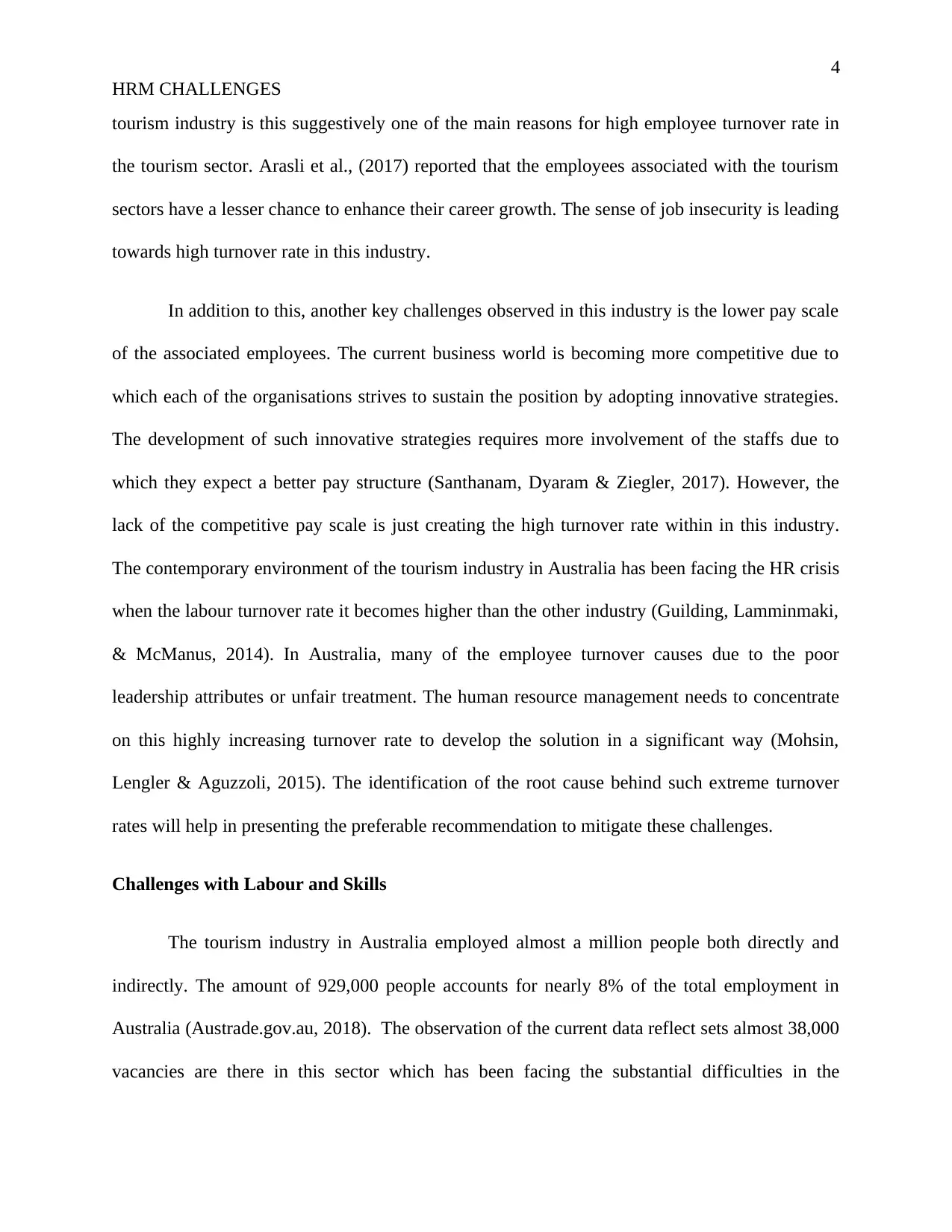
4
HRM CHALLENGES
tourism industry is this suggestively one of the main reasons for high employee turnover rate in
the tourism sector. Arasli et al., (2017) reported that the employees associated with the tourism
sectors have a lesser chance to enhance their career growth. The sense of job insecurity is leading
towards high turnover rate in this industry.
In addition to this, another key challenges observed in this industry is the lower pay scale
of the associated employees. The current business world is becoming more competitive due to
which each of the organisations strives to sustain the position by adopting innovative strategies.
The development of such innovative strategies requires more involvement of the staffs due to
which they expect a better pay structure (Santhanam, Dyaram & Ziegler, 2017). However, the
lack of the competitive pay scale is just creating the high turnover rate within in this industry.
The contemporary environment of the tourism industry in Australia has been facing the HR crisis
when the labour turnover rate it becomes higher than the other industry (Guilding, Lamminmaki,
& McManus, 2014). In Australia, many of the employee turnover causes due to the poor
leadership attributes or unfair treatment. The human resource management needs to concentrate
on this highly increasing turnover rate to develop the solution in a significant way (Mohsin,
Lengler & Aguzzoli, 2015). The identification of the root cause behind such extreme turnover
rates will help in presenting the preferable recommendation to mitigate these challenges.
Challenges with Labour and Skills
The tourism industry in Australia employed almost a million people both directly and
indirectly. The amount of 929,000 people accounts for nearly 8% of the total employment in
Australia (Austrade.gov.au, 2018). The observation of the current data reflect sets almost 38,000
vacancies are there in this sector which has been facing the substantial difficulties in the
HRM CHALLENGES
tourism industry is this suggestively one of the main reasons for high employee turnover rate in
the tourism sector. Arasli et al., (2017) reported that the employees associated with the tourism
sectors have a lesser chance to enhance their career growth. The sense of job insecurity is leading
towards high turnover rate in this industry.
In addition to this, another key challenges observed in this industry is the lower pay scale
of the associated employees. The current business world is becoming more competitive due to
which each of the organisations strives to sustain the position by adopting innovative strategies.
The development of such innovative strategies requires more involvement of the staffs due to
which they expect a better pay structure (Santhanam, Dyaram & Ziegler, 2017). However, the
lack of the competitive pay scale is just creating the high turnover rate within in this industry.
The contemporary environment of the tourism industry in Australia has been facing the HR crisis
when the labour turnover rate it becomes higher than the other industry (Guilding, Lamminmaki,
& McManus, 2014). In Australia, many of the employee turnover causes due to the poor
leadership attributes or unfair treatment. The human resource management needs to concentrate
on this highly increasing turnover rate to develop the solution in a significant way (Mohsin,
Lengler & Aguzzoli, 2015). The identification of the root cause behind such extreme turnover
rates will help in presenting the preferable recommendation to mitigate these challenges.
Challenges with Labour and Skills
The tourism industry in Australia employed almost a million people both directly and
indirectly. The amount of 929,000 people accounts for nearly 8% of the total employment in
Australia (Austrade.gov.au, 2018). The observation of the current data reflect sets almost 38,000
vacancies are there in this sector which has been facing the substantial difficulties in the
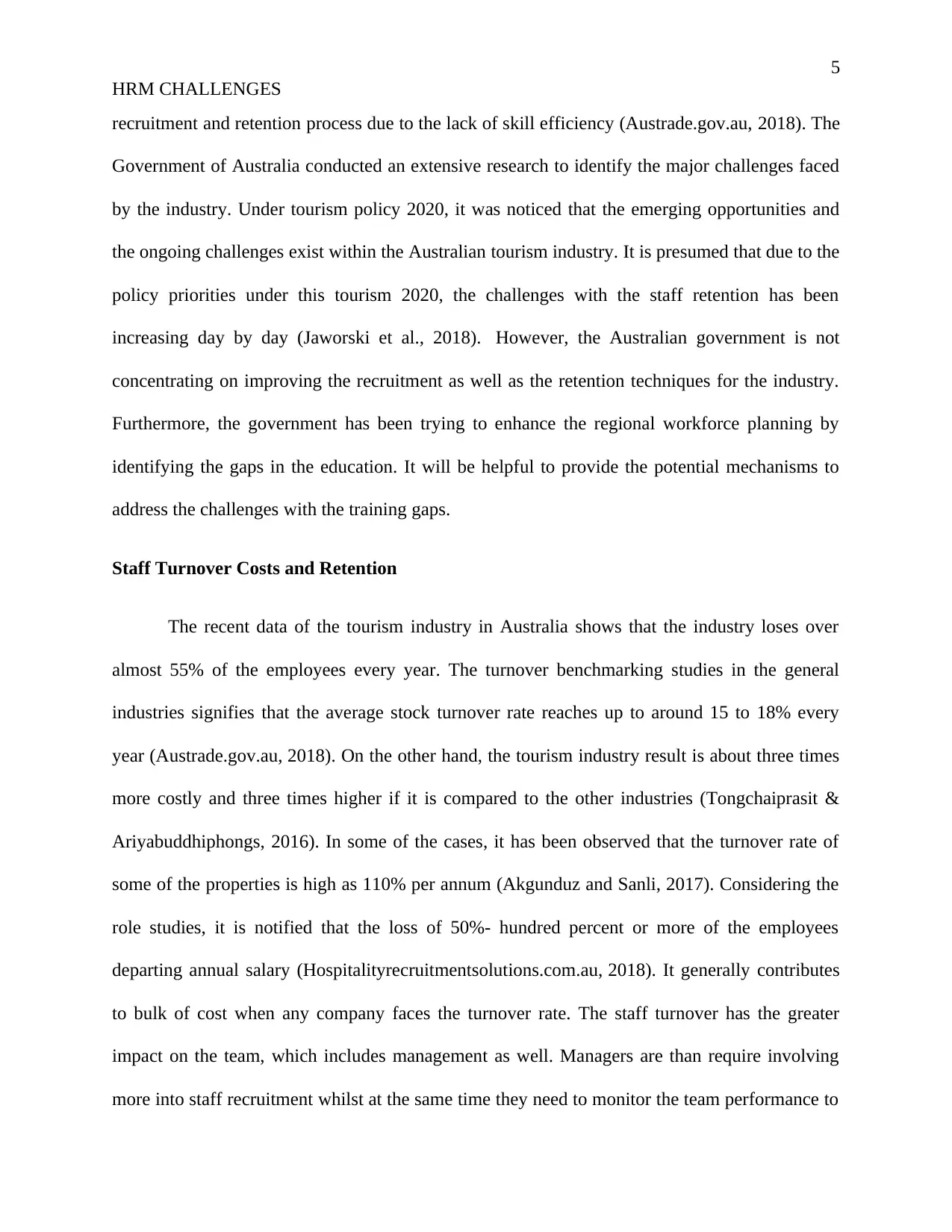
5
HRM CHALLENGES
recruitment and retention process due to the lack of skill efficiency (Austrade.gov.au, 2018). The
Government of Australia conducted an extensive research to identify the major challenges faced
by the industry. Under tourism policy 2020, it was noticed that the emerging opportunities and
the ongoing challenges exist within the Australian tourism industry. It is presumed that due to the
policy priorities under this tourism 2020, the challenges with the staff retention has been
increasing day by day (Jaworski et al., 2018). However, the Australian government is not
concentrating on improving the recruitment as well as the retention techniques for the industry.
Furthermore, the government has been trying to enhance the regional workforce planning by
identifying the gaps in the education. It will be helpful to provide the potential mechanisms to
address the challenges with the training gaps.
Staff Turnover Costs and Retention
The recent data of the tourism industry in Australia shows that the industry loses over
almost 55% of the employees every year. The turnover benchmarking studies in the general
industries signifies that the average stock turnover rate reaches up to around 15 to 18% every
year (Austrade.gov.au, 2018). On the other hand, the tourism industry result is about three times
more costly and three times higher if it is compared to the other industries (Tongchaiprasit &
Ariyabuddhiphongs, 2016). In some of the cases, it has been observed that the turnover rate of
some of the properties is high as 110% per annum (Akgunduz and Sanli, 2017). Considering the
role studies, it is notified that the loss of 50%- hundred percent or more of the employees
departing annual salary (Hospitalityrecruitmentsolutions.com.au, 2018). It generally contributes
to bulk of cost when any company faces the turnover rate. The staff turnover has the greater
impact on the team, which includes management as well. Managers are than require involving
more into staff recruitment whilst at the same time they need to monitor the team performance to
HRM CHALLENGES
recruitment and retention process due to the lack of skill efficiency (Austrade.gov.au, 2018). The
Government of Australia conducted an extensive research to identify the major challenges faced
by the industry. Under tourism policy 2020, it was noticed that the emerging opportunities and
the ongoing challenges exist within the Australian tourism industry. It is presumed that due to the
policy priorities under this tourism 2020, the challenges with the staff retention has been
increasing day by day (Jaworski et al., 2018). However, the Australian government is not
concentrating on improving the recruitment as well as the retention techniques for the industry.
Furthermore, the government has been trying to enhance the regional workforce planning by
identifying the gaps in the education. It will be helpful to provide the potential mechanisms to
address the challenges with the training gaps.
Staff Turnover Costs and Retention
The recent data of the tourism industry in Australia shows that the industry loses over
almost 55% of the employees every year. The turnover benchmarking studies in the general
industries signifies that the average stock turnover rate reaches up to around 15 to 18% every
year (Austrade.gov.au, 2018). On the other hand, the tourism industry result is about three times
more costly and three times higher if it is compared to the other industries (Tongchaiprasit &
Ariyabuddhiphongs, 2016). In some of the cases, it has been observed that the turnover rate of
some of the properties is high as 110% per annum (Akgunduz and Sanli, 2017). Considering the
role studies, it is notified that the loss of 50%- hundred percent or more of the employees
departing annual salary (Hospitalityrecruitmentsolutions.com.au, 2018). It generally contributes
to bulk of cost when any company faces the turnover rate. The staff turnover has the greater
impact on the team, which includes management as well. Managers are than require involving
more into staff recruitment whilst at the same time they need to monitor the team performance to
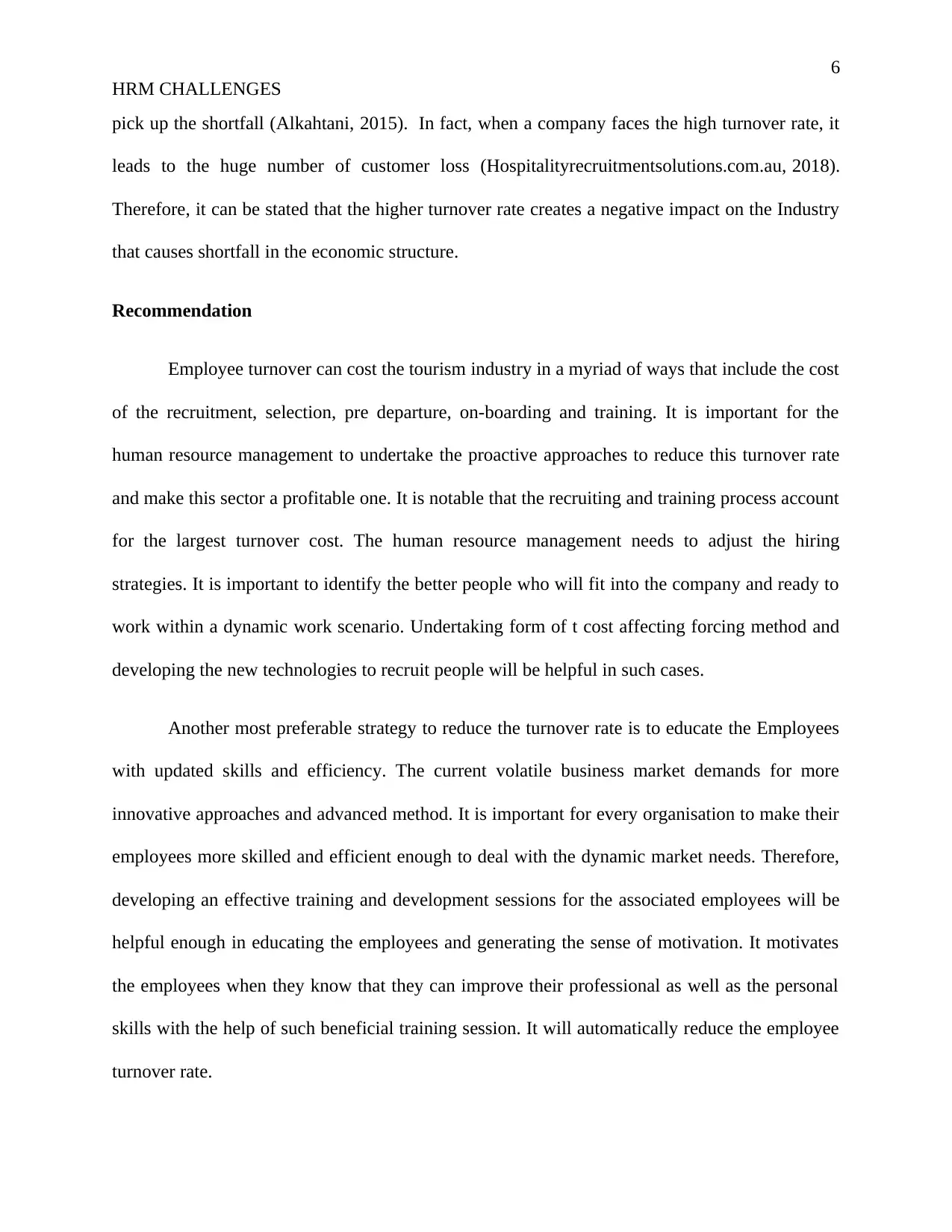
6
HRM CHALLENGES
pick up the shortfall (Alkahtani, 2015). In fact, when a company faces the high turnover rate, it
leads to the huge number of customer loss (Hospitalityrecruitmentsolutions.com.au, 2018).
Therefore, it can be stated that the higher turnover rate creates a negative impact on the Industry
that causes shortfall in the economic structure.
Recommendation
Employee turnover can cost the tourism industry in a myriad of ways that include the cost
of the recruitment, selection, pre departure, on-boarding and training. It is important for the
human resource management to undertake the proactive approaches to reduce this turnover rate
and make this sector a profitable one. It is notable that the recruiting and training process account
for the largest turnover cost. The human resource management needs to adjust the hiring
strategies. It is important to identify the better people who will fit into the company and ready to
work within a dynamic work scenario. Undertaking form of t cost affecting forcing method and
developing the new technologies to recruit people will be helpful in such cases.
Another most preferable strategy to reduce the turnover rate is to educate the Employees
with updated skills and efficiency. The current volatile business market demands for more
innovative approaches and advanced method. It is important for every organisation to make their
employees more skilled and efficient enough to deal with the dynamic market needs. Therefore,
developing an effective training and development sessions for the associated employees will be
helpful enough in educating the employees and generating the sense of motivation. It motivates
the employees when they know that they can improve their professional as well as the personal
skills with the help of such beneficial training session. It will automatically reduce the employee
turnover rate.
HRM CHALLENGES
pick up the shortfall (Alkahtani, 2015). In fact, when a company faces the high turnover rate, it
leads to the huge number of customer loss (Hospitalityrecruitmentsolutions.com.au, 2018).
Therefore, it can be stated that the higher turnover rate creates a negative impact on the Industry
that causes shortfall in the economic structure.
Recommendation
Employee turnover can cost the tourism industry in a myriad of ways that include the cost
of the recruitment, selection, pre departure, on-boarding and training. It is important for the
human resource management to undertake the proactive approaches to reduce this turnover rate
and make this sector a profitable one. It is notable that the recruiting and training process account
for the largest turnover cost. The human resource management needs to adjust the hiring
strategies. It is important to identify the better people who will fit into the company and ready to
work within a dynamic work scenario. Undertaking form of t cost affecting forcing method and
developing the new technologies to recruit people will be helpful in such cases.
Another most preferable strategy to reduce the turnover rate is to educate the Employees
with updated skills and efficiency. The current volatile business market demands for more
innovative approaches and advanced method. It is important for every organisation to make their
employees more skilled and efficient enough to deal with the dynamic market needs. Therefore,
developing an effective training and development sessions for the associated employees will be
helpful enough in educating the employees and generating the sense of motivation. It motivates
the employees when they know that they can improve their professional as well as the personal
skills with the help of such beneficial training session. It will automatically reduce the employee
turnover rate.
Paraphrase This Document
Need a fresh take? Get an instant paraphrase of this document with our AI Paraphraser
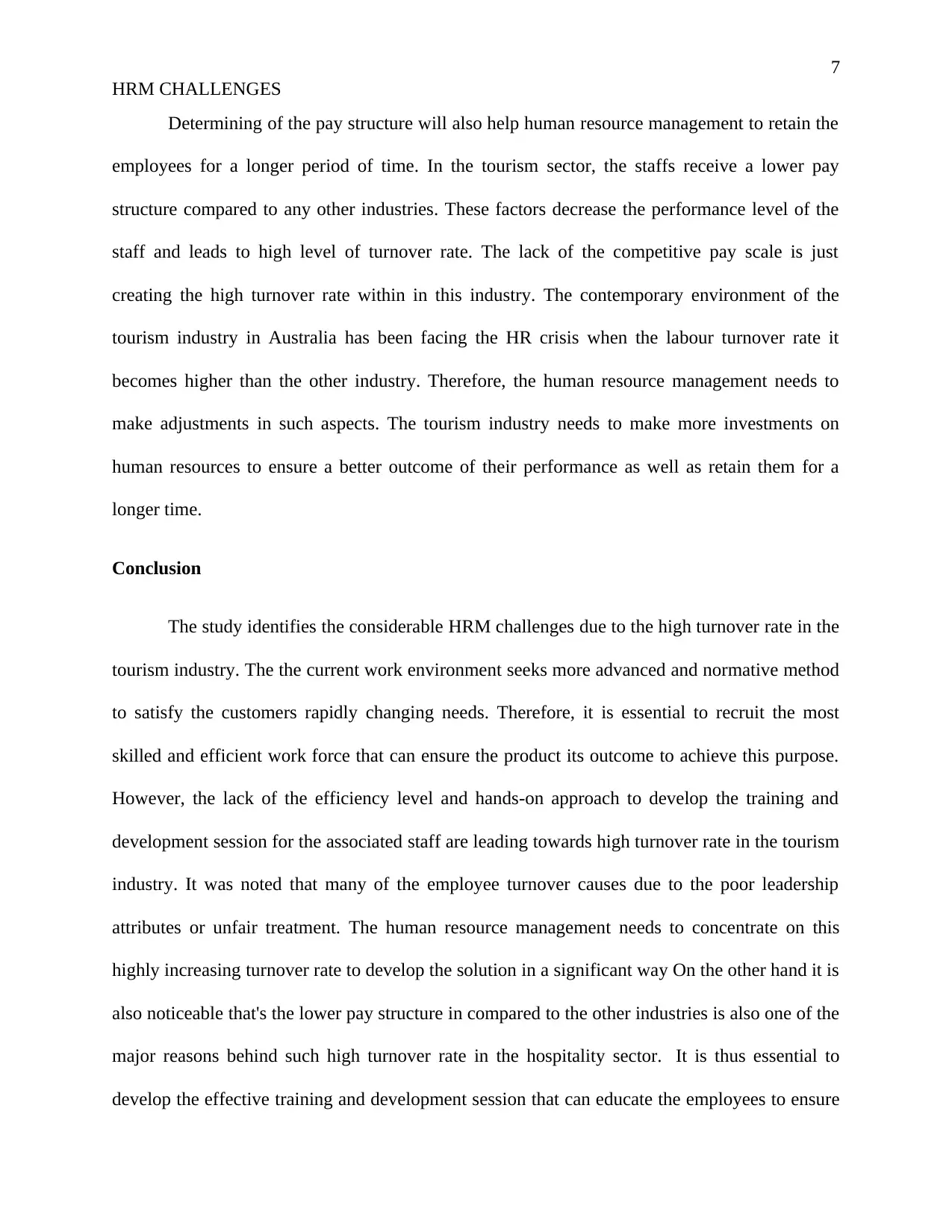
7
HRM CHALLENGES
Determining of the pay structure will also help human resource management to retain the
employees for a longer period of time. In the tourism sector, the staffs receive a lower pay
structure compared to any other industries. These factors decrease the performance level of the
staff and leads to high level of turnover rate. The lack of the competitive pay scale is just
creating the high turnover rate within in this industry. The contemporary environment of the
tourism industry in Australia has been facing the HR crisis when the labour turnover rate it
becomes higher than the other industry. Therefore, the human resource management needs to
make adjustments in such aspects. The tourism industry needs to make more investments on
human resources to ensure a better outcome of their performance as well as retain them for a
longer time.
Conclusion
The study identifies the considerable HRM challenges due to the high turnover rate in the
tourism industry. The the current work environment seeks more advanced and normative method
to satisfy the customers rapidly changing needs. Therefore, it is essential to recruit the most
skilled and efficient work force that can ensure the product its outcome to achieve this purpose.
However, the lack of the efficiency level and hands-on approach to develop the training and
development session for the associated staff are leading towards high turnover rate in the tourism
industry. It was noted that many of the employee turnover causes due to the poor leadership
attributes or unfair treatment. The human resource management needs to concentrate on this
highly increasing turnover rate to develop the solution in a significant way On the other hand it is
also noticeable that's the lower pay structure in compared to the other industries is also one of the
major reasons behind such high turnover rate in the hospitality sector. It is thus essential to
develop the effective training and development session that can educate the employees to ensure
HRM CHALLENGES
Determining of the pay structure will also help human resource management to retain the
employees for a longer period of time. In the tourism sector, the staffs receive a lower pay
structure compared to any other industries. These factors decrease the performance level of the
staff and leads to high level of turnover rate. The lack of the competitive pay scale is just
creating the high turnover rate within in this industry. The contemporary environment of the
tourism industry in Australia has been facing the HR crisis when the labour turnover rate it
becomes higher than the other industry. Therefore, the human resource management needs to
make adjustments in such aspects. The tourism industry needs to make more investments on
human resources to ensure a better outcome of their performance as well as retain them for a
longer time.
Conclusion
The study identifies the considerable HRM challenges due to the high turnover rate in the
tourism industry. The the current work environment seeks more advanced and normative method
to satisfy the customers rapidly changing needs. Therefore, it is essential to recruit the most
skilled and efficient work force that can ensure the product its outcome to achieve this purpose.
However, the lack of the efficiency level and hands-on approach to develop the training and
development session for the associated staff are leading towards high turnover rate in the tourism
industry. It was noted that many of the employee turnover causes due to the poor leadership
attributes or unfair treatment. The human resource management needs to concentrate on this
highly increasing turnover rate to develop the solution in a significant way On the other hand it is
also noticeable that's the lower pay structure in compared to the other industries is also one of the
major reasons behind such high turnover rate in the hospitality sector. It is thus essential to
develop the effective training and development session that can educate the employees to ensure
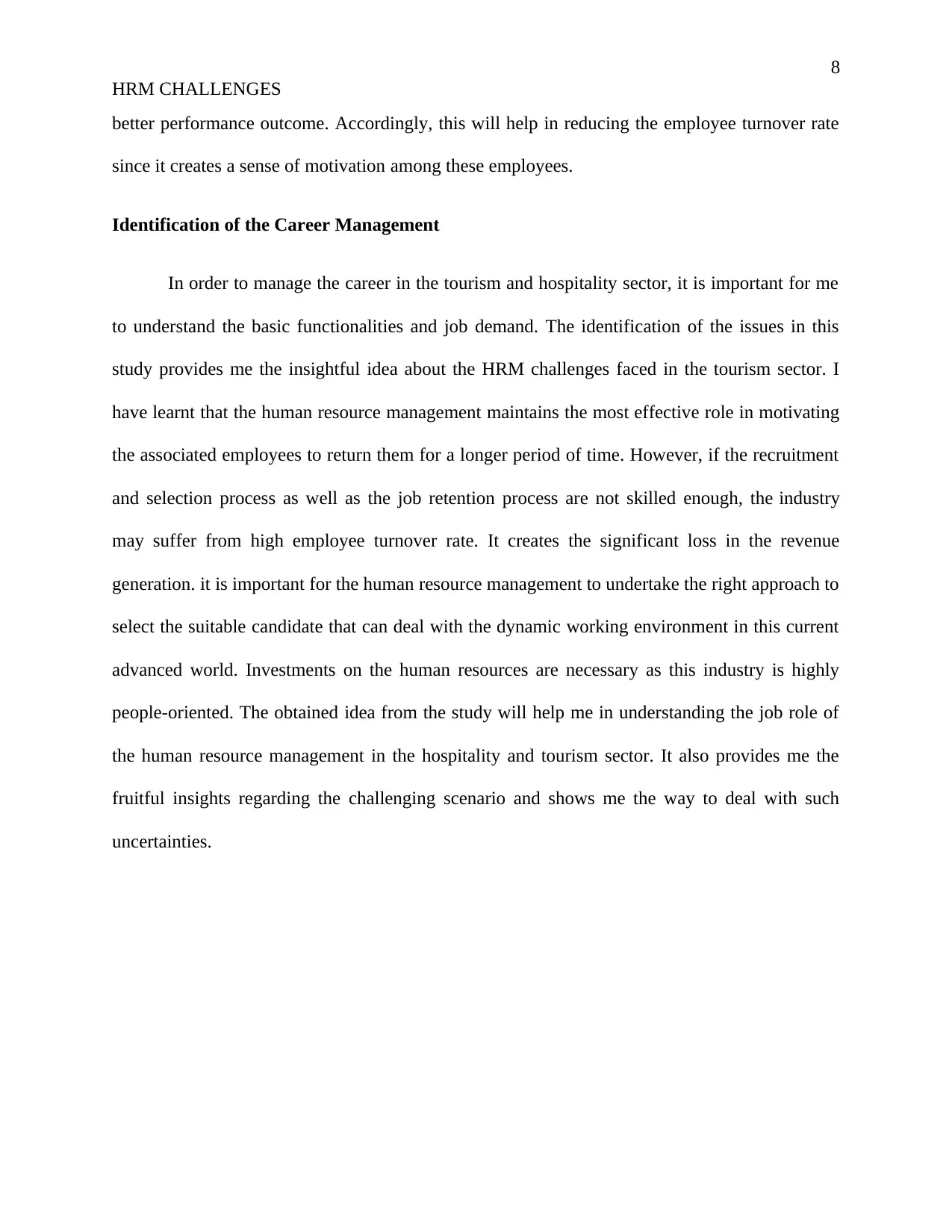
8
HRM CHALLENGES
better performance outcome. Accordingly, this will help in reducing the employee turnover rate
since it creates a sense of motivation among these employees.
Identification of the Career Management
In order to manage the career in the tourism and hospitality sector, it is important for me
to understand the basic functionalities and job demand. The identification of the issues in this
study provides me the insightful idea about the HRM challenges faced in the tourism sector. I
have learnt that the human resource management maintains the most effective role in motivating
the associated employees to return them for a longer period of time. However, if the recruitment
and selection process as well as the job retention process are not skilled enough, the industry
may suffer from high employee turnover rate. It creates the significant loss in the revenue
generation. it is important for the human resource management to undertake the right approach to
select the suitable candidate that can deal with the dynamic working environment in this current
advanced world. Investments on the human resources are necessary as this industry is highly
people-oriented. The obtained idea from the study will help me in understanding the job role of
the human resource management in the hospitality and tourism sector. It also provides me the
fruitful insights regarding the challenging scenario and shows me the way to deal with such
uncertainties.
HRM CHALLENGES
better performance outcome. Accordingly, this will help in reducing the employee turnover rate
since it creates a sense of motivation among these employees.
Identification of the Career Management
In order to manage the career in the tourism and hospitality sector, it is important for me
to understand the basic functionalities and job demand. The identification of the issues in this
study provides me the insightful idea about the HRM challenges faced in the tourism sector. I
have learnt that the human resource management maintains the most effective role in motivating
the associated employees to return them for a longer period of time. However, if the recruitment
and selection process as well as the job retention process are not skilled enough, the industry
may suffer from high employee turnover rate. It creates the significant loss in the revenue
generation. it is important for the human resource management to undertake the right approach to
select the suitable candidate that can deal with the dynamic working environment in this current
advanced world. Investments on the human resources are necessary as this industry is highly
people-oriented. The obtained idea from the study will help me in understanding the job role of
the human resource management in the hospitality and tourism sector. It also provides me the
fruitful insights regarding the challenging scenario and shows me the way to deal with such
uncertainties.
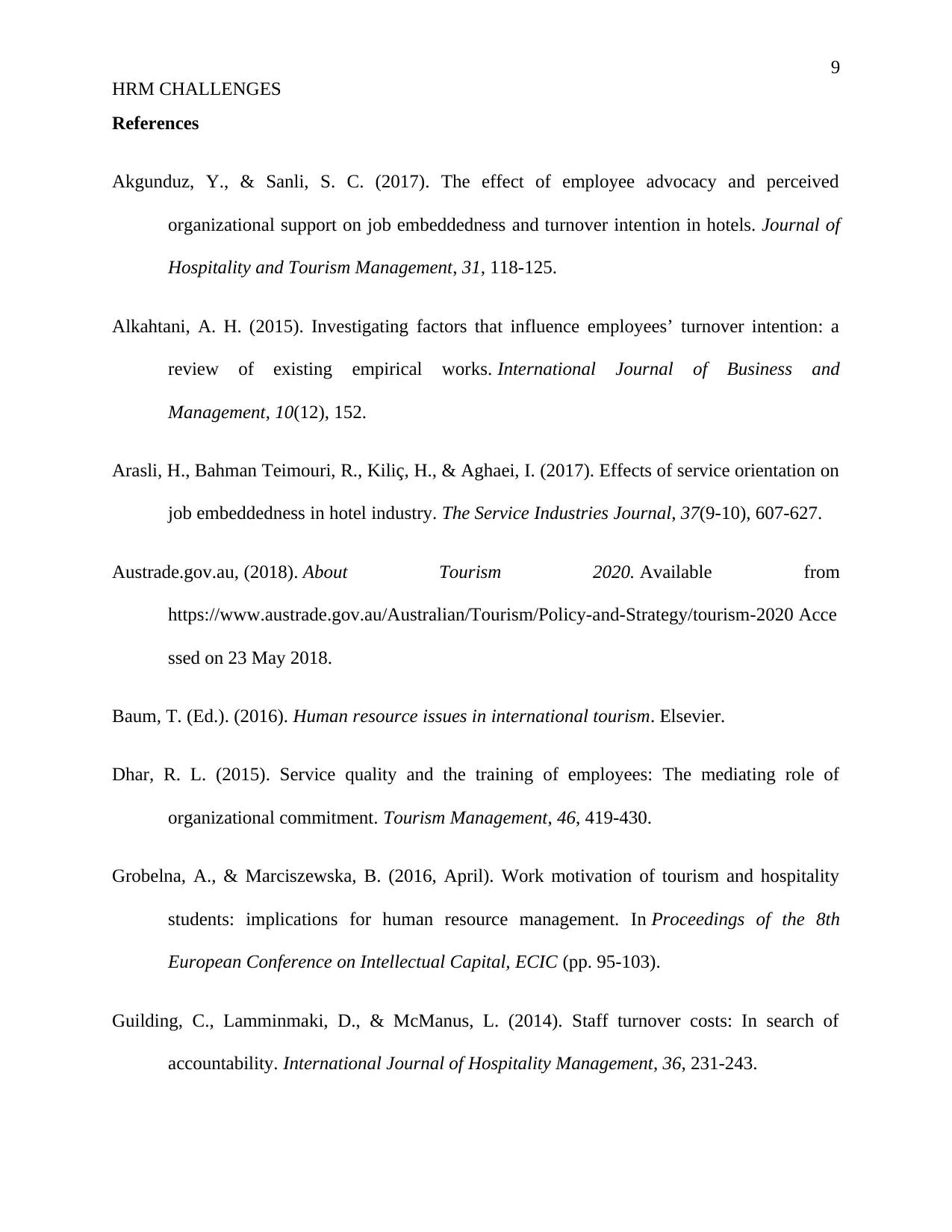
9
HRM CHALLENGES
References
Akgunduz, Y., & Sanli, S. C. (2017). The effect of employee advocacy and perceived
organizational support on job embeddedness and turnover intention in hotels. Journal of
Hospitality and Tourism Management, 31, 118-125.
Alkahtani, A. H. (2015). Investigating factors that influence employees’ turnover intention: a
review of existing empirical works. International Journal of Business and
Management, 10(12), 152.
Arasli, H., Bahman Teimouri, R., Kiliç, H., & Aghaei, I. (2017). Effects of service orientation on
job embeddedness in hotel industry. The Service Industries Journal, 37(9-10), 607-627.
Austrade.gov.au, (2018). About Tourism 2020. Available from
https://www.austrade.gov.au/Australian/Tourism/Policy-and-Strategy/tourism-2020 Acce
ssed on 23 May 2018.
Baum, T. (Ed.). (2016). Human resource issues in international tourism. Elsevier.
Dhar, R. L. (2015). Service quality and the training of employees: The mediating role of
organizational commitment. Tourism Management, 46, 419-430.
Grobelna, A., & Marciszewska, B. (2016, April). Work motivation of tourism and hospitality
students: implications for human resource management. In Proceedings of the 8th
European Conference on Intellectual Capital, ECIC (pp. 95-103).
Guilding, C., Lamminmaki, D., & McManus, L. (2014). Staff turnover costs: In search of
accountability. International Journal of Hospitality Management, 36, 231-243.
HRM CHALLENGES
References
Akgunduz, Y., & Sanli, S. C. (2017). The effect of employee advocacy and perceived
organizational support on job embeddedness and turnover intention in hotels. Journal of
Hospitality and Tourism Management, 31, 118-125.
Alkahtani, A. H. (2015). Investigating factors that influence employees’ turnover intention: a
review of existing empirical works. International Journal of Business and
Management, 10(12), 152.
Arasli, H., Bahman Teimouri, R., Kiliç, H., & Aghaei, I. (2017). Effects of service orientation on
job embeddedness in hotel industry. The Service Industries Journal, 37(9-10), 607-627.
Austrade.gov.au, (2018). About Tourism 2020. Available from
https://www.austrade.gov.au/Australian/Tourism/Policy-and-Strategy/tourism-2020 Acce
ssed on 23 May 2018.
Baum, T. (Ed.). (2016). Human resource issues in international tourism. Elsevier.
Dhar, R. L. (2015). Service quality and the training of employees: The mediating role of
organizational commitment. Tourism Management, 46, 419-430.
Grobelna, A., & Marciszewska, B. (2016, April). Work motivation of tourism and hospitality
students: implications for human resource management. In Proceedings of the 8th
European Conference on Intellectual Capital, ECIC (pp. 95-103).
Guilding, C., Lamminmaki, D., & McManus, L. (2014). Staff turnover costs: In search of
accountability. International Journal of Hospitality Management, 36, 231-243.
Secure Best Marks with AI Grader
Need help grading? Try our AI Grader for instant feedback on your assignments.
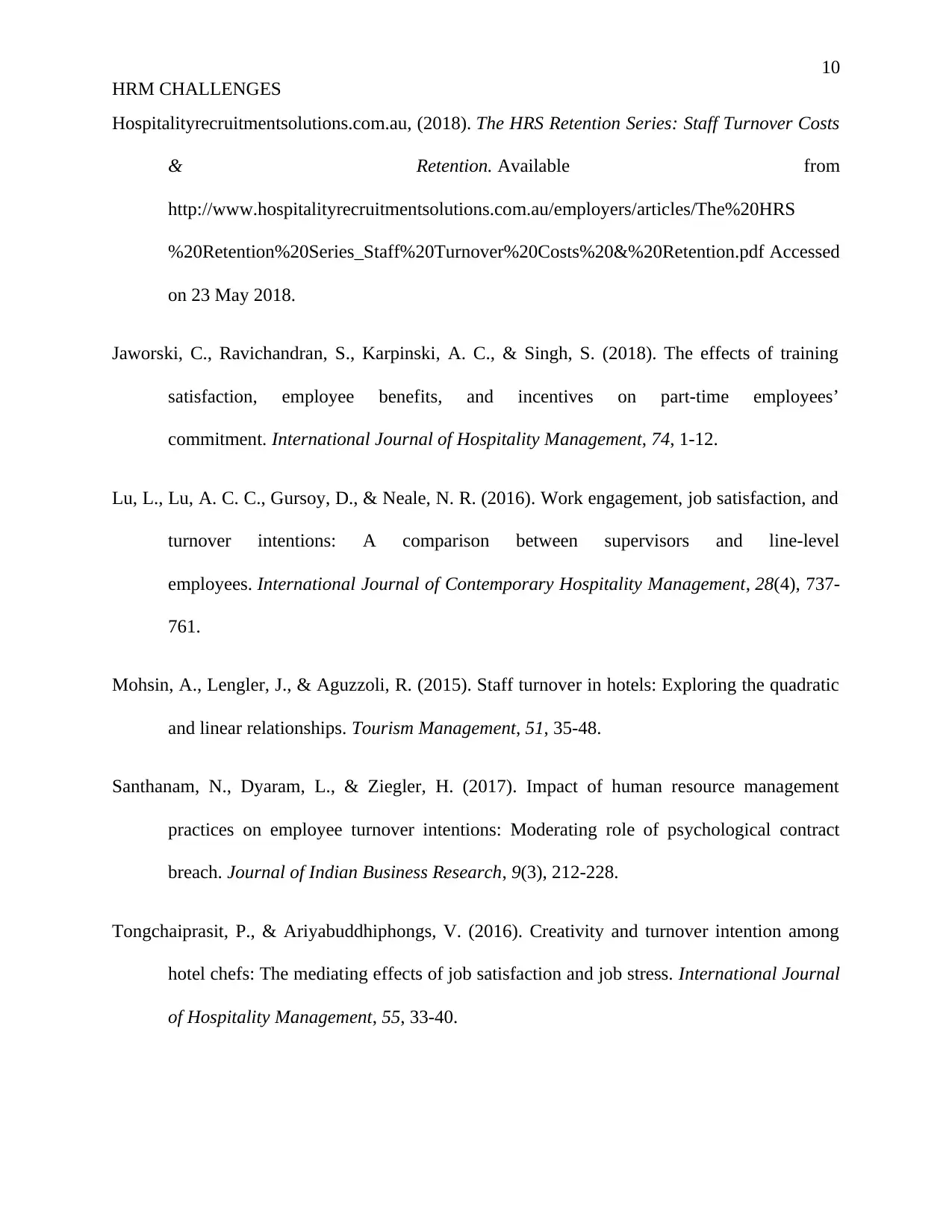
10
HRM CHALLENGES
Hospitalityrecruitmentsolutions.com.au, (2018). The HRS Retention Series: Staff Turnover Costs
& Retention. Available from
http://www.hospitalityrecruitmentsolutions.com.au/employers/articles/The%20HRS
%20Retention%20Series_Staff%20Turnover%20Costs%20&%20Retention.pdf Accessed
on 23 May 2018.
Jaworski, C., Ravichandran, S., Karpinski, A. C., & Singh, S. (2018). The effects of training
satisfaction, employee benefits, and incentives on part-time employees’
commitment. International Journal of Hospitality Management, 74, 1-12.
Lu, L., Lu, A. C. C., Gursoy, D., & Neale, N. R. (2016). Work engagement, job satisfaction, and
turnover intentions: A comparison between supervisors and line-level
employees. International Journal of Contemporary Hospitality Management, 28(4), 737-
761.
Mohsin, A., Lengler, J., & Aguzzoli, R. (2015). Staff turnover in hotels: Exploring the quadratic
and linear relationships. Tourism Management, 51, 35-48.
Santhanam, N., Dyaram, L., & Ziegler, H. (2017). Impact of human resource management
practices on employee turnover intentions: Moderating role of psychological contract
breach. Journal of Indian Business Research, 9(3), 212-228.
Tongchaiprasit, P., & Ariyabuddhiphongs, V. (2016). Creativity and turnover intention among
hotel chefs: The mediating effects of job satisfaction and job stress. International Journal
of Hospitality Management, 55, 33-40.
HRM CHALLENGES
Hospitalityrecruitmentsolutions.com.au, (2018). The HRS Retention Series: Staff Turnover Costs
& Retention. Available from
http://www.hospitalityrecruitmentsolutions.com.au/employers/articles/The%20HRS
%20Retention%20Series_Staff%20Turnover%20Costs%20&%20Retention.pdf Accessed
on 23 May 2018.
Jaworski, C., Ravichandran, S., Karpinski, A. C., & Singh, S. (2018). The effects of training
satisfaction, employee benefits, and incentives on part-time employees’
commitment. International Journal of Hospitality Management, 74, 1-12.
Lu, L., Lu, A. C. C., Gursoy, D., & Neale, N. R. (2016). Work engagement, job satisfaction, and
turnover intentions: A comparison between supervisors and line-level
employees. International Journal of Contemporary Hospitality Management, 28(4), 737-
761.
Mohsin, A., Lengler, J., & Aguzzoli, R. (2015). Staff turnover in hotels: Exploring the quadratic
and linear relationships. Tourism Management, 51, 35-48.
Santhanam, N., Dyaram, L., & Ziegler, H. (2017). Impact of human resource management
practices on employee turnover intentions: Moderating role of psychological contract
breach. Journal of Indian Business Research, 9(3), 212-228.
Tongchaiprasit, P., & Ariyabuddhiphongs, V. (2016). Creativity and turnover intention among
hotel chefs: The mediating effects of job satisfaction and job stress. International Journal
of Hospitality Management, 55, 33-40.

11
HRM CHALLENGES
HRM CHALLENGES
1 out of 12
Related Documents
Your All-in-One AI-Powered Toolkit for Academic Success.
+13062052269
info@desklib.com
Available 24*7 on WhatsApp / Email
![[object Object]](/_next/static/media/star-bottom.7253800d.svg)
Unlock your academic potential
© 2024 | Zucol Services PVT LTD | All rights reserved.





